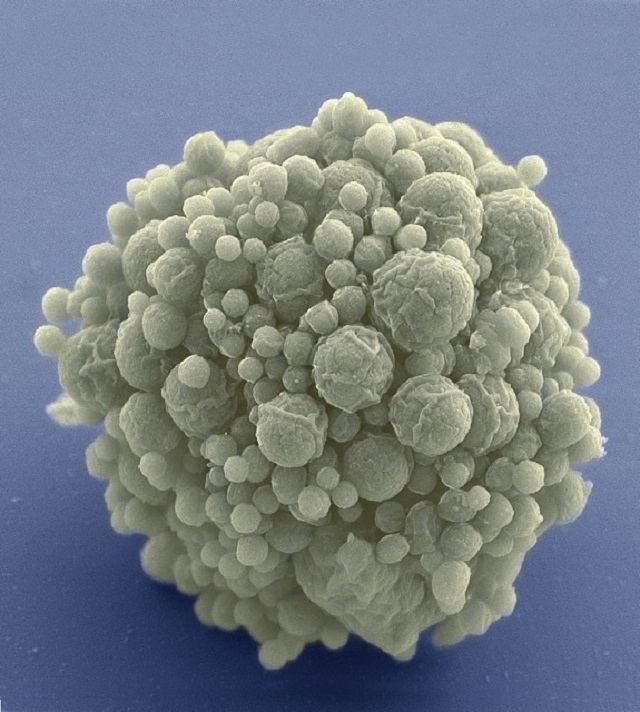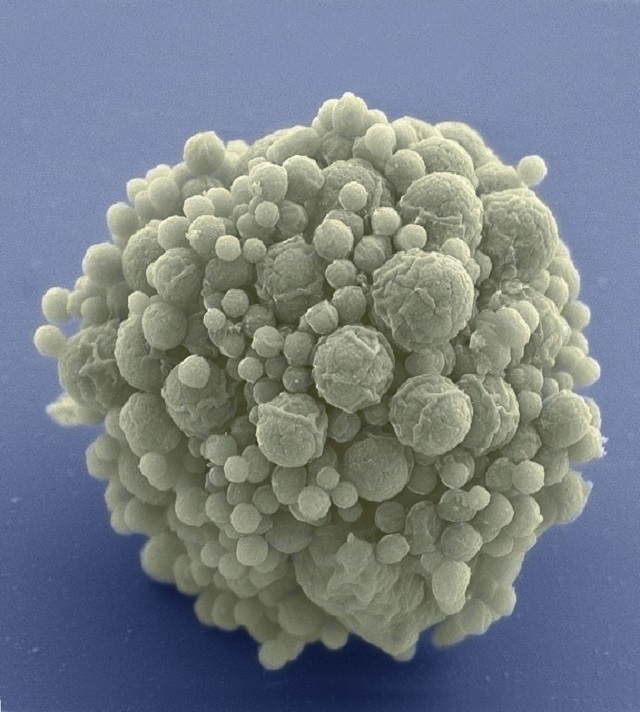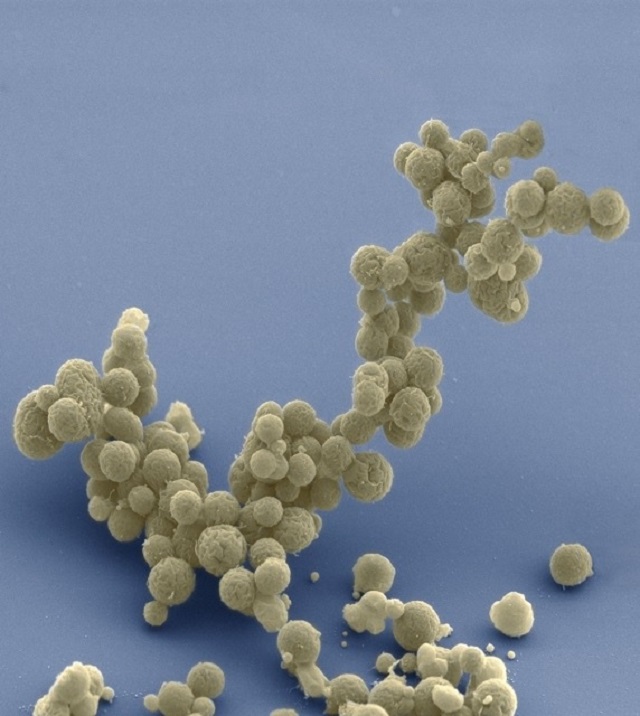It looks like you're using an Ad Blocker.
Please white-list or disable AboveTopSecret.com in your ad-blocking tool.
Thank you.
Some features of ATS will be disabled while you continue to use an ad-blocker.
share:
Scientist created a life form whose genome doesn't exist in nature. They don't know what 31% of it's DNA does. There could be some very good
breakthroughs through this research but there could also be a downside because you can create an organism that could do some serious damage and that
can't be stopped.
www.bloomberg.com...
Maybe there's a reason why something with 473 genes doesn't exist in nature. You have to keep moving forward with this though because the benefits can be really great and human curiosity means it will be done somewhere.
Genomics pioneer Craig Venter and more than 20 colleagues engineered a living microbe with a genome simpler than any seen in nature. In other words, they created a life form whose relative simplicity and modular design make it a platform that one day may be as easily manipulated as, say, software. Setting aside fears of Blade Runner replicants running amok, the breakthrough revealed on Thursday in the journal Science may hold promise for a new era in medicine, industry, and energy.
“These cells would be a very, very useful chassis for many industrial applications, from medicine to biochemicals, biofuels, nutrition, and agriculture,” said Dan Gibson, a top scientist at both Venter’s research institute and his company, Synthetic Genomics Inc. Ultimately, the group wants to understand the tiny genetic framework well enough to use it as a biological foundation for more complex organisms that could address many of the world's ills. Once each essential gene's function is identified, scientists can build an effective computer model of it; from there, they can simulate how best to go about “adding pathways for the production of useful products,” they wrote.
Scientists have long theorized how many genes might be required for a simple, viable organism that could be used as a universal template. Many studies have tried to estimate the rock-bottom number by knocking out individual genes; they have settled on 250 to 300 or so. The original bacteria species that the Venter group worked on is already pretty tiny: M. mycoides is found in cow stomachs and has about 985 genes. The human genome has more than 20,000 genes. Golden Delicious apples have more than 57,000 genes. The new organism, nicknamed Syn3.0 by researchers? It has 473.
www.bloomberg.com...
Maybe there's a reason why something with 473 genes doesn't exist in nature. You have to keep moving forward with this though because the benefits can be really great and human curiosity means it will be done somewhere.
Thanks for sharing. Hopefully this can prove useful for humanity, and the world at large.
a reply to: neoholographic
What if it decides humans are food and eats the scientists ?
I'm disappointed there's no pictures I wanted to see what "it" looks like
What if it decides humans are food and eats the scientists ?
I'm disappointed there's no pictures I wanted to see what "it" looks like
Just because we haven't seen it, doesn't mean it wasn't already there just waiting. Kinda like Columbus discovered America? a reply to:
neoholographic
originally posted by: ozmnpo
a reply to: Discotech
Here is a link with a picture
JCVI-syn3.0
Thanks for the link. Here's the pic:
Syn3.0

This creeps me out. Not sure why clinically or theoretically. It just does
2.5 million years and we're not half as sophisticated as an apple.
Humbling.
Humbling.
Sure let's create life that we don't understand anything about..
a reply to: grey580
Are domesticated animals
a) smarter, and more fearsome
b) dumber and less fearsome
than wild animals?
These protobacteria haven't survived any natural evolutionary pressure and would be wiped out in the real world. Once programmed, they'd be like idiot savants, excellent at one thing while in an institution and incompetent otherwise.
Are domesticated animals
a) smarter, and more fearsome
b) dumber and less fearsome
than wild animals?
These protobacteria haven't survived any natural evolutionary pressure and would be wiped out in the real world. Once programmed, they'd be like idiot savants, excellent at one thing while in an institution and incompetent otherwise.
originally posted by: Discotech
a reply to: neoholographic
What if it decides humans are food and eats the scientists ?
I'm disappointed there's no pictures I wanted to see what "it" looks like
There are plenty of bacteria and virus that have already decided this. That's why some people can get gangrene or those infections like Mucormycosis.
The fewer genes that a bacteria has, the less flexibility it has in tolerating changes in it's environment. These modifications wouldn't last five minutes given the damage to DNA from sunlight or the competition from other organisms.
a reply to: neoholographic
Hopefully we'll use it in medical applications, and it will run rampant in our systems. Maybe start rewriting our genes or something cool like that.
Hopefully we'll use it in medical applications, and it will run rampant in our systems. Maybe start rewriting our genes or something cool like that.
Maybe doing this on Earth isn't a the best of ideas. Nothing could go wrong, could it?
Apply Murphy's Law and end up with Grey Goo.
Apply Murphy's Law and end up with Grey Goo.
Grey goo is a hypothetical end-of-the-world scenario involving molecular nanotechnology in which out-of-control self-replicating robots consume all matter on Earth while building more of themselves, a scenario that has been called ecophagy ("eating the environment", more literally "eating the habitation"). The original idea assumed machines were designed to have this capability, while popularizations have assumed that machines might somehow gain this capability by accident.
The term was first used by molecular nanotechnology pioneer Eric Drexler in his book Engines of Creation (1986). In Chapter 4, Engines Of Abundance, Drexler illustrates both exponential growth and inherent limits (not gray goo) by describing nanomachines that can function only if given special raw materials:
Imagine such a replicator floating in a bottle of chemicals, making copies of itself…the first replicator assembles a copy in one thousand seconds, the two replicators then build two more in the next thousand seconds, the four build another four, and the eight build another eight. At the end of ten hours, there are not thirty-six new replicators, but over 68 billion. In less than a day, they would weigh a ton; in less than two days, they would outweigh the Earth; in another four hours, they would exceed the mass of the Sun and all the planets combined — if the bottle of chemicals hadn't run dry long before.
In a History Channel broadcast, a contrasting idea (a kind of gray goo) is referred to in a futuristic doomsday scenario: "In a common practice, billions of nanobots are released to clean up an oil spill off the coast of Louisiana. However, due to a programming error, the nanobots devour all carbon based objects, instead of just the hydrocarbons of the oil. The nanobots destroy everything, all the while, replicating themselves. Within days, the planet is turned to dust."
Grey Goo
I want to know what it was supposed to do.
I'm sure it's being weaponized as we speak. lol.
I'm sure it's being weaponized as we speak. lol.
a reply to: neoholographic
Insane. What if the universe and everything in it was made by some other life form that was fooling around and trying to make a new life outside of nature. What if WE are a dumbed down version of a better an more complex life form.
Insane. What if the universe and everything in it was made by some other life form that was fooling around and trying to make a new life outside of nature. What if WE are a dumbed down version of a better an more complex life form.
new topics
-
Are you ready for the return of Jesus Christ? Have you been cleansed by His blood?
Religion, Faith, And Theology: 26 minutes ago -
Chronological time line of open source information
History: 1 hours ago -
A man of the people
Diseases and Pandemics: 3 hours ago -
Ramblings on DNA, blood, and Spirit.
Philosophy and Metaphysics: 3 hours ago -
4 plans of US elites to defeat Russia
New World Order: 4 hours ago -
Thousands Of Young Ukrainian Men Trying To Flee The Country To Avoid Conscription And The War
Other Current Events: 8 hours ago -
12 jurors selected in Trump criminal trial
US Political Madness: 11 hours ago -
Iran launches Retalliation Strike 4.18.24
World War Three: 11 hours ago -
Israeli Missile Strikes in Iran, Explosions in Syria + Iraq
World War Three: 11 hours ago
top topics
-
George Knapp AMA on DI
Area 51 and other Facilities: 17 hours ago, 26 flags -
Israeli Missile Strikes in Iran, Explosions in Syria + Iraq
World War Three: 11 hours ago, 17 flags -
Thousands Of Young Ukrainian Men Trying To Flee The Country To Avoid Conscription And The War
Other Current Events: 8 hours ago, 6 flags -
Iran launches Retalliation Strike 4.18.24
World War Three: 11 hours ago, 6 flags -
Not Aliens but a Nazi Occult Inspired and then Science Rendered Design.
Aliens and UFOs: 17 hours ago, 5 flags -
12 jurors selected in Trump criminal trial
US Political Madness: 11 hours ago, 4 flags -
4 plans of US elites to defeat Russia
New World Order: 4 hours ago, 2 flags -
A man of the people
Diseases and Pandemics: 3 hours ago, 2 flags -
Chronological time line of open source information
History: 1 hours ago, 2 flags -
Ramblings on DNA, blood, and Spirit.
Philosophy and Metaphysics: 3 hours ago, 1 flags
active topics
-
4 plans of US elites to defeat Russia
New World Order • 24 • : twistedpuppy -
BREAKING: O’Keefe Media Uncovers who is really running the White House
US Political Madness • 16 • : Hakaiju -
Are you ready for the return of Jesus Christ? Have you been cleansed by His blood?
Religion, Faith, And Theology • 2 • : 727Sky -
Thousands Of Young Ukrainian Men Trying To Flee The Country To Avoid Conscription And The War
Other Current Events • 6 • : Macenroe1982 -
Fossils in Greece Suggest Human Ancestors Evolved in Europe, Not Africa
Origins and Creationism • 65 • : Xtrozero -
The Tories may be wiped out after the Election - Serves them Right
Regional Politics • 24 • : crayzeed -
A man of the people
Diseases and Pandemics • 7 • : TheMichiganSwampBuck -
Israeli Missile Strikes in Iran, Explosions in Syria + Iraq
World War Three • 54 • : CarlLaFong -
12 jurors selected in Trump criminal trial
US Political Madness • 30 • : RazorV66 -
Meet Catturd who has been swatted 3 times
General Conspiracies • 22 • : 7dayhome




